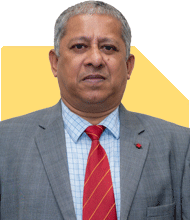Ramalingam Kalirajan |8227 Answers |Ask -Follow
Mutual Funds, Financial Planning Expert - Answered on Apr 11, 2024
He has an MBA in finance from the University of Madras and is a certified financial planner.
He is the director and chief financial planner at Holistic Investment, a Chennai-based firm that offers financial planning and wealth management advice.... more

Sir. Im 35 yrs old with 2 kids aged 3 and 10 months respectively. I have 3 lakhs in MF and 4.5 lakhs in ppf. 5 lakhs FD. Started MF SIP in my kids names each 5k. Where else should I invest ?
Equity Mutual Funds: Since you have already started SIPs in your kids' names, you could continue investing in diversified equity mutual funds for potential long-term growth. These funds offer exposure to stocks across various sectors and market capitalizations.
Debt Mutual Funds: To balance your portfolio and reduce overall risk, consider investing in debt mutual funds. These funds primarily invest in fixed-income securities such as government bonds, corporate bonds, and money market instruments. They offer relatively stable returns compared to equity funds.
Child Education Planning: Since your children are young, you may want to start planning for their education expenses. Consider setting up separate investment accounts or education funds specifically designated for their future educational needs.
Term Insurance: As a parent, it's essential to ensure financial protection for your family in case of unforeseen events. Consider purchasing a term insurance policy to provide financial security to your dependents in the event of your untimely demise.
Emergency Fund: Build an emergency fund equivalent to at least 6-12 months of your household expenses. This fund should be easily accessible and kept in liquid assets such as savings accounts or liquid mutual funds to cover unexpected expenses or financial emergencies.
Retirement Planning: Start planning for your retirement by investing in retirement-focused instruments such as the National Pension System (NPS), Public Provident Fund (PPF), or Employee Provident Fund (EPF). These instruments offer tax benefits and help in building a corpus for your post-retirement years.
It's essential to assess your risk tolerance, investment objectives, and time horizon before making any investment decisions. Consider consulting with a financial advisor to develop a customized investment plan tailored to your specific needs and goals.
You may like to see similar questions and answers below
Nikunj Saraf |308 Answers |Ask -Follow
Mutual Funds Expert - Answered on May 23, 2023
Ulhas Joshi | Answer |Ask -Follow
Mutual Fund Expert - Answered on May 12, 2023
Ramalingam Kalirajan |8227 Answers |Ask -Follow
Mutual Funds, Financial Planning Expert - Answered on May 20, 2024
Ramalingam Kalirajan |8227 Answers |Ask -Follow
Mutual Funds, Financial Planning Expert - Answered on Jan 11, 2025
Dr Nagarajan Jsk |319 Answers |Ask -Follow
NEET, Medical, Pharmacy Careers - Answered on Apr 14, 2025
Dr Nagarajan Jsk |319 Answers |Ask -Follow
NEET, Medical, Pharmacy Careers - Answered on Apr 14, 2025
Prof Suvasish Mukhopadhyay |567 Answers |Ask -Follow
Career Counsellor - Answered on Apr 14, 2025
Prof Suvasish Mukhopadhyay |567 Answers |Ask -Follow
Career Counsellor - Answered on Apr 14, 2025
Prof Suvasish Mukhopadhyay |567 Answers |Ask -Follow
Career Counsellor - Answered on Apr 14, 2025
Prof Suvasish Mukhopadhyay |567 Answers |Ask -Follow
Career Counsellor - Answered on Apr 14, 2025
Prof Suvasish Mukhopadhyay |567 Answers |Ask -Follow
Career Counsellor - Answered on Apr 14, 2025
Prof Suvasish Mukhopadhyay |567 Answers |Ask -Follow
Career Counsellor - Answered on Apr 14, 2025
Prof Suvasish Mukhopadhyay |567 Answers |Ask -Follow
Career Counsellor - Answered on Apr 14, 2025
Prof Suvasish Mukhopadhyay |567 Answers |Ask -Follow
Career Counsellor - Answered on Apr 14, 2025






















